HIGHLIGHTS
Moderate Investor
- Characteristics
- Medium Risk Level
- Income Generation & Capital Appreciation
- Balanced Strategy
- Time Horizon
- Moderate Investment Options:
- Income Funds
- Repurchase Agreements (Repos)
- Fixed Deposits
- Bonds
- Balanced Mutual Funds
- Equity Mutual Funds/ Index ETFs
This week, we at Bourse continue with the second instalment of our three-part series aimed at helping individuals better determine the types of investments they should consider, based on their specific investor profile. Investors – looking through the lens of risk tolerance – may better focus on investment solutions to help achieve their goals without being unduly comfortable in the risks taken. Having covered the Conservative Investor Portfolio in our previous article, we consider the ‘Moderate’ Investor, highlighting several traits, investment options and a portfolio mix that should fit the risk tolerance associated with the investor profile.
Investor Breakdown
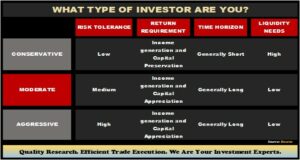
Investor profiles broadly describe different types of investors based on their risk tolerance, return requirement, investment time horizon and liquidity needs. To reiterate, investors are typically categorized into three (3) basic profiles: Conservative, Moderate and Aggressive.
The Conservative Investor prioritizes income generation and preserving of capital, with limited focus on capital appreciation. The Conservative Investor usually focuses on loss minimization, as opposed to return maximization.
The Moderate Investor, which is this article’s focus, is prepared to take on moderate risk in exchange for generating returns through a combination of income generation and capital appreciation. Some losses and/or fluctuations to invested funds are tolerable for this investor.
The Aggressive Investor, in order to maximize returns, is prepared to take on greater risk. This investor is typically very focused on growing wealth as quickly as possible, cognizant that his/her investments may fluctuate significantly in value.
Are You a Moderate Investor?
The Moderate Investor tends to display the following traits:
- Measured Risk-taking. Moderate investors are willing to accept some portfolio volatility in exchange for greater potential returns. Accordingly, a meaningful portion of this investor’s portfolio would be invested in securities whose values may fluctuate.
- Balanced Return sources. The Moderate investor aims to grow wealth through a combination of capital growth and income, opting for investments including but not limited to ‘value’ stocks and medium-to-longer term bonds.
- Liquidity. Liquidity needs for the Moderate Investor tend to be lower, on the understanding that the riskier portion of his/her portfolio should be able to remain invested to weather the impact of economic and/or financial market cycles. Relative to the Conservative Investor, a smaller component of the Moderate Investor’s portfolio would be invested in very liquid assets.
- Time Horizon. With a lower liquidity preference and seeking growth in capital, the Moderate Investor’s time horizon tends be longer. Investing in medium term bonds (5-10 years) is common, as are investments in value stocks for the longer-term.
When Should I Be a Moderate Investor?
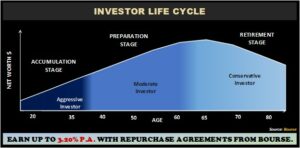
As highlighted in our first instalment, the Investor Life Cycle typically encompasses three basic stages: Accumulation, Preparation and Retirement. Each stage involves different investment strategies tailored to the investor’s age, risk tolerance, investment horizon and financial goals.
Moderate Investors are often associated with the Preparation Stage (Age 35-60) of the investor life cycle. Within this stage, investors’ portfolios have a longer runway to recover from the inevitable economic and/or market cycles which can affect the value of stocks for periods of time. Accordingly, investors have the flexibility to take more risk in the pursuit of higher returns.
The Moderate Investor Menu
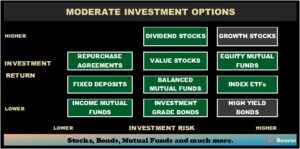
In addition to Conservative investment options such as Income Mutual Funds, Fixed Deposits, Repurchase Agreements and Dividend Stocks (detailed in our previous article), the Moderate Investor’s menu includes options such as ‘Value’ stocks, Investment Grade Bonds, Balanced Mutual Funds and Equity Mutual Funds/Index ETFs.
Bonds
Bonds are fixed income instruments in which a lender (investor) loans money to a borrower (bond issuer). In return, the investor receives periodic coupon (interest payments) at fixed and known dates with principal returned on the final maturity date. Bonds issuers include governments, state enterprises and corporations. Bonds tenors typically range from 3 years to 30 years. Bonds also vary in risk, usually reflected by its credit rating.
For the Moderate Investor, medium-term (5 to 10 year) bonds with higher credit quality may be more appropriate in achieving investment objectives.
Balanced/’Growth & Income’ Mutual Funds
A balanced mutual fund is an investment fund that includes a mix of stocks, bonds and other securities within a single portfolio, offering medium to long-term growth. The goal is to provide a balanced approach to investing by combining the growth potential of equities with the income and stability of fixed-income investments. Balanced Mutual Funds are sometimes referred to as ‘Growth & Income Funds’. Retirement Mutual Funds are another example of investment vehicles which offer a built-in balanced portfolio approach.
Equity Mutual Fund/ Equity ETFs
An equity mutual fund is a type of mutual fund that invests its assets generally in stocks or shares of various companies for the long term to benefit the investors. Equity Mutual Funds traded over stock exchanges are referred to as Equity Exchange Traded Funds or Equity ETFs. For the Moderate investor, Equity Mutual Funds/ETFs are useful tools to construct a balanced portfolio with ready-made diversification benefits. Equity Mutual Funds/ETFs may be focused on a specific sector or may focus on broad market exposure (referred to as Index ETFs).
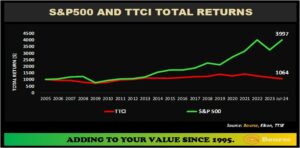
Moderate (and Aggressive) investors are willing to take more risk though equities in exchange for potentially higher returns. Just how much additional return is available through equity investments?
Looking at the S&P500 Index performance from December 2005 to July 2024, despite multiple extraordinary events, economic cycles and other market-moving factors, the S&P500 Index grew at an annualized rate of 7.1% (excluding dividends) over the period. The Trinidad and Tobago Composite Index (TTCI), during the same period, grew at an average 0.6% annualized rate.
How Much Can a Moderate Portfolio Earn?
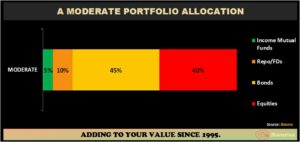
With a better idea of the portfolio building blocks for the Moderate Investor, just how much could such a portfolio earn?
A sample Moderate Investor portfolio allocation might comprise 5% in Income Mutual Funds, 10% in Repos/FDs, 45% in Government and Corporate bonds and 40% in Equities. When considering prevailing returns on each of these types of investments, the weighted return on the Moderate portfolio would range between 5.0% – 5.25%.
Like the Conservative investor portfolio with its return of 3.8%, the Moderate investor portfolio’s expected return (5.0% – 5.25%) would outpace 5-year average inflation in T&T of 2.8%.
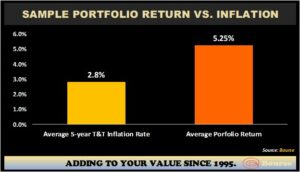
In addition to choosing the most appropriate investments from a risk-perspective, we reiterate the importance of (i) building a well-diversified portfolio, (ii) incorporating investments in foreign currencies, if possible and (iii) adopting a long-term approach to your investment portfolio. Next week, we shall explore the portfolio of a ‘Aggressive’ Investor and their investment options.
DISCLAIMER: “This document has been prepared by Bourse Securities Limited, (“Bourse”), for information purposes only. The production of this publication is not to in any way establish an offer or solicit for the subscription, purchase, or sale of any of the securities stated herein to US persons or to contradict any laws of jurisdictions which would interpret our research to be an offer. Any trade in securities recommended herein is done subject to the fact that Bourse, its subsidiaries and/or affiliates have or may have specific or potential conflicts of interest in respect of the security or the issuer of the security, including those arising from (i) trading or dealing in certain securities and acting as an investment advisor; (ii) holding of securities of the issuer as beneficial owner; (iii) having benefitted, benefitting or to benefit from compensation arrangements; (iv) acting as underwriter in any distribution of securities of the issuer in the three years immediately preceding this document; or (v) having direct or indirect financial or other interest in the security or the issuer of the security. Investors are advised accordingly. Neither Bourse nor any of its subsidiaries, affiliates directors, officers, employees, representatives, or agents, accepts any liability whatsoever for any direct, indirect or consequential losses arising from the use of this document or its contents or reliance on the information contained herein. Bourse does not guarantee the accuracy or completeness of the information in this document, which may have been obtained from or is based upon trade and statistical services or other third-party sources. The information in this document is not intended to predict actual results and no assurances are given with respect thereto.”

